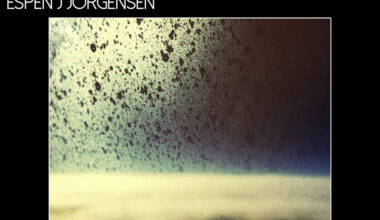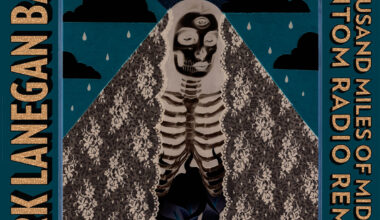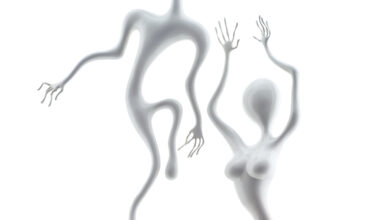Opal / Universal

The worst toilet in Scotland. A skinny heroin addict enters a filthy, broken stall at the back of a bookmakers. The scene shifts into dream-like fantasy as the youth tries desperately to retrieve the suppositories he’s accidentally jettisoned into the bowl, in the process diving down the porcelain into a world of sub-aquatic serenity. As he swims to the bottom, a gentle, ethereal soundscape of country guitar and steady bass notes begins to rise up, all watery tones and beatific, almost elegiac, melodic layers. It’s ‘Trainspotting’, of course. The cue is ‘Deep Blue Day’ by Brian Eno, originally from his 1983 album, ‘Apollo: Atmospheres And Soundtracks’.
Film music has been an omnipresent fascination of Eno’s solo career, both in terms of commissions for soundtracks, but also as an early exponent of the imaginary score. In 1978, ‘Music For Films’ acted like a calling card. A collection of hypothetical soundtrack pieces, most were subsequently picked up by production companies and used for real.
The music made under his ambient aesthetic was, in many ways, always destined for use in this way. An exercise in dramatic subtlety, his distinctive compositions were intricate, but ideally suited to the action taking place on screen. This is not because they lacked substance. If you listen to his work closely, there are frequently jarring moments of uncomfortable discordancy, such as on his theme from Yann Demange’s, ‘Top Boy’, or ‘Prophecy Theme’ from David Lynch’s ‘Dune’ or ‘Late Evening In Jersey’ from Michael Mann’s ‘Heat’. It’s those moments that create a palpable sense of mystery, uncertainty and tension, themselves the essential tools of the director.
By 1976, the starting point for this new compilation, Eno had already dabbled, attaching his music to work by avant-garde British director Malcolm Le Grice and the prolific Greek filmmaker Kostas Karagiannis. But the earliest work featured here is ‘Final Sunset’ from ‘Sebastiane’, which marks not only the beginning of his relationship with Derek Jarman, but the development of his pioneering concept of ambient music.
The set travels through an impressive roster of directors, from the big screen to small screen and on into art house. There is a crude split here too between the specifically commissioned and the ready-made, where a studio could easily find ample music to complement a particular scene from Eno’s expansive body of work. We also get unreleased pieces from his more recent commissions, ‘Design As Reduction’ from Gary Hustwit’s ‘Rams’ and, bringing us right up to date, ‘Reasonable Question’ from this year’s ‘We Are As Gods’ by David Alvarado and Jason Sussberg.
In both of these pieces, Eno’s signature tones are attached to jerky, unpredictable and almost self-generating rhythms. Remove those rhythms and they could easily be one of the two featured early pieces created for Derek Jarman – the aforementioned ‘Final Sunset’ and ‘Dover Beach’ from 1978’s ‘Jubilee’. In other hands, this might appear like a lack of progress on the composer’s part. In Eno’s case it reflects how deeply rooted his commitment is to this softly fluctuating form of music, both in his electronic structures and in his vocals – the plaintive, dubby ‘Under’ (from ‘Cool World’, directed by Ralph Bakshi) and the soulful cover of ‘You Don’t Miss Your Water’ (from Jonathan Demme’s ‘Married to the Mob’) contain Eno’s reassuring, almost chorally-arranged voice, positioned in such a way as to make it inseparable from the surrounding instrumentation.
Eno has never been in an exclusive relationship with electronics, and this isn’t an entirely electronic album. ‘Blood Red’ from a BBC ‘Arena’ piece on Francis Bacon has emotive, jazzy woodwind passages and a bed of chirping creatures, ‘Beach Sequence’, originally used in Michelangelo Antonioni’s ‘Beyond The Clouds’, is led by a haunting piano refrain from Bono, while ‘The Sombre’ from ‘Top Boy – Series 2’ sounds like it was created on a droning pump organ. The precise timbres rarely matter. Irrespective of what instrumentation Eno opts to employ, the result has the same textural levity.
Listened to as a whole, ‘Film Music (1976–2020)’ has a weightlessness, almost as if the title refers not to celluloid, but a gossamer-thin, almost ephemeral layer that precisely evokes what Eno does better than anyone else. It’s perhaps unlikely that his music would ever be used to augment a chase scene or the intensity of a Hitchcockian murder sequence, instead, his work, whether commissioned or borrowed from his back catalogue, has an openness that can make any scene, in any piece of film, by any director, significantly more engaging.





